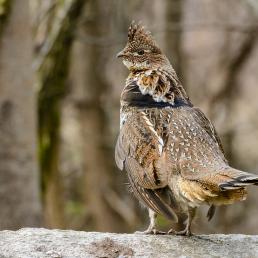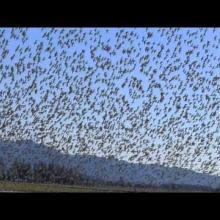

Join BirdNote tomorrow, November 30th!
Illustrator David Sibley and actor H. Jon Benjamin will face off in the bird illustration battle of the century during BirdNote's Year-end Celebration and Auction!
The Western Sandpiper makes an annual migration from its winter home in South America to Alaska, where it breeds in summer. For years, scientists thought the birds fueled their journey by foraging for aquatic invertebrates, like beetles and mussels, along the way. But new research suggests they are also sucking up biofilm, using their hairy tongues, on the mudflats in the Fraser River Estuary on Canada’s Pacific Coast.
Find out more about this vital food source, and efforts to protect it, on the Threatened podcast.
BirdNote®
Western Sandpipers' Hairy Tongues
By Molly Segal
[Western Sandpiper ML263038261]
This is BirdNote.
Weighing in at about an ounce, the Western Sandpiper is a tiny shorebird that makes an annual migration along the Pacific Flyway, from its winter home in South America to Alaska, where it breeds in summer.
For years, scientists thought Western Sandpipers were mostly foraging for aquatic invertebrates, like beetles and mussels, on their long journey. But as we learn more, a different picture is emerging.
Something called biofilm is found on the mudflats in the Fraser River Estuary on Canada’s Pacific Coast.
Pat Baird: So it's that film that you see, like a sheen. Because it's a film, but it has biological creatures in it.
Pat Baird is a marine biologist at Simon Fraser University in British Columbia, Canada.
She says there are tiny algae, called diatoms, in the biofilm out on the mudflats.
When the winter melt happens in the spring, fresh water makes its way to the sea via the estuary. And that changes what the diatoms do. From photosynthesizing carbohydrates…
Pat Baird: ...to making fatty acids. The crux of the whole thing’s the timing. The whole thing’s a perfect storm of timing that makes the diatoms in the phytoplankton completely change their physiology.
And Western Sandpipers have a special adaptation to take advantage of it—a hairy tongue that allows them to suck up the biofilm with its special fatty acid-producing diatoms.
Scientists like Pat are concerned that development in the Fraser Estuary could put this vital food source in jeopardy. To learn more about the efforts to protect it, subscribe to Threatened wherever you get your podcasts.
For BirdNote, I’m Molly Segal.
###
Producer: John Kessler
Production Manager: Allison Wilson
Editor: Ari Daniel
Producer: Molly Segal
Associate Producer: Ellen Blackstone
Field Recordings by Molly Segal
Additional sounds provided by The Macaulay Library of Natural Sounds at the Cornell Lab of Ornithology, Ithaca, New York. Western Sandpiper ML263038261 recorded by Tayler Brooks.
© 2020 BirdNote December 2020 Narrator: Molly Segal
ID# WESA-02-2020-12-08 WESA-02



